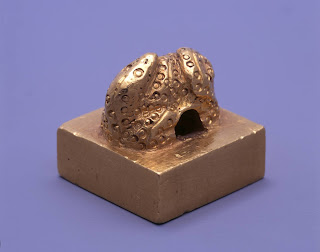On December 14th, 1931, the Golden Seal was chosen as a national treasure of Japan. In 1978, it was donated to Fukuoka city. The seal has been the most renowned collection of the Fukuoka City Museum since the museum’s opening in 1990.
 |
| Gold Seal |
 |
| The seal’s bottom face |
The seal’s grip is in the shape of a snake. The seal’s bottom face is small and with a size of 2.3 square centimeters. The seal is made of 95% pure gold and weighs 108g. One of the five Chinese characters inscribed on the seal's surface is 委. The character is considered to represent 倭. 倭奴國 is considered as the name of a state that was once existed in the Fukuoka area. So, the inscribed character collectively state that the seal was bestowed to the king of Na state. The king of Na was famous for sending envoys to the then Chinese Emperor Guang of the later Han Dynasty. There are several theories about the Na state’s location, but the strongest one suggests that 倭奴國 which is actually 奴国, a country which unified the areas in the South-Eastern part of the Mikasagawa river area and the entire area of the Nakagawa river.
 |
| Cray Seal |
The Golden Seal was used to secure the contents of articles which were inscribed on bamboo or wooden tablets. After binding the tablets together with a thread, a lump of clay was attached to the knot and then sealed with the Golden Seal. The cray hardens after it was dried out and the receiver had to break the cray to see the contents. The lump of cray was called 封泥 (Cray Seal) and it proved the document was kept confidential.
Seals in ancient times are usually inscribed with the name of a sender, his or her rank and the administrative body to which he/she belonged, and to identify the sender. Seals used in ancient China also had motifs on the grip which were often in the shape of snake, camel, or turtle. The seal was accompanied with a strap to wear it around the holder’s neck. The shape of seal grip, the color, and the length of the strap precisely determined the wearer’s rank or their position to clearly show who they were.
By acquiring the Gold seal, the Na County was included in China hierarchically and was granted governance of their territory by a Chinese Emperor. Counties in the Northern Kyushu area in that period acquired a lot of cultures and civilizations and backed by support from China. Thus, making a great leap forward to improve socially and culturally.
Date back to the Edo period. The gold seal was found in a place now known as the Shikanoshima Island in 1784. The seal was found under a large stone by Jinbei, who was a farmer, while he was fixing ditches in his paddy field. The event was reported t
o the local government of Kasuya County in the form of the document titled Ko-jutsusho. Since then, the seal was derived from the Kuroda family, a leading family of the Fukuoka Clan.
During the Meiji period or later, multiple numbers of excavation researches were held on Shikanoshima Island but there were no other findings that relate to the Gold Seal. Why the golden seal was found on the Shikano Shima Island, where is distantly located from the central part of the Na-County? It is one of the biggest historical mystery in Japan. Above all, no evidence suggests that the seal was found from Shikanoshima Island. Some theories pose answers to the questions regarding the origin of the Golden Seal. One of the theories suggests that the Gold Seal was a fake created in the Edo period. There is also a theory that suggests the seal was found from the different tomb of the Yayoi Period but falsely stated that it was found in the Shikanoshima Island.
The details of the seal remain a mystery. That is why the seal still attracts people’s attention as a mysterious national treasure and arouse their interest in Japanese history.

0 件のコメント:
コメントを投稿